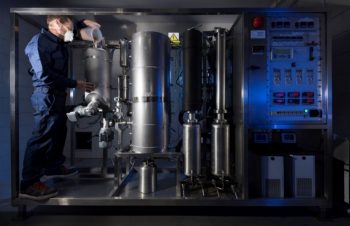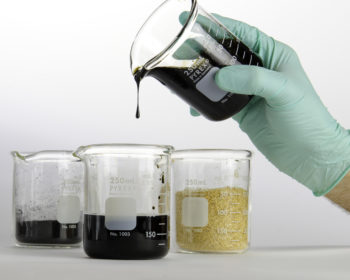Key Points

Fast Pyrolysis System at Scion in New Zealand, PyNe42.
- Pyrolysis can make liquid biofuel from solid biomass using rapid heating in a low oxygen environment.
- Fast pyrolysis occurs when transferring heat in a few seconds, giving maximum liquid product.
- The product is called “Bio-oil” that can be burned as biofuel or converted to higher value products or fuels.
- The process uses rapid heat transfer and a low oxygen environment to cause thermal reactions that break down the biomass polymer structure to form a liquid.
Further Reading
Example Applications
Pyrolysis

Bio-oil, char, and pine sawdust. Photo: Scott Butner, PNNL.
Pyrolysis is thermal decomposition occurring in the absence of oxygen. It is always also the first step in combustion and gasification processes where it is followed by total or partial oxidation of the primary products. Lower process temperature and longer vapor residence times favor the production of charcoal. High temperature and longer residence time increase the biomass conversion to gas and moderate temperature and short vapor residence time are optimum for producing liquids. The product distribution obtained from different modes of pyrolysis process are summarized in the table below. Fast pyrolysis for liquids production is of particular interest currently as the liquids are transportable and storage.
Typical product yields (dry wood basis) obtained by different modes of pyrolysis of wood
| Mode | Conditions Wt% | Liquid | Char | Gas |
| Fast | ~500oC, short hot vapor residence time ~1 s | 75% | 12% | 13% |
| Intermediate | ~500oC, hot vapor residence time ~10-30 s | 50% | 25% | 25% |
| Slow – Torrefaction | ~290oC, solids residence time ~30 mins | – | 82% solid | 18% |
| Slow – Carbonization | ~400oC, long vapor residence time hrs -> days | 30% | 35% | 35% |
| Gasification | ~800oC | 5% | 10% | 85% |
Fast pyrolysis occurs in a time of few seconds or less. Therefore, not only chemical reaction kinetics but also heat and mass transfer processes, as well as phase transition phenomena, play important roles. The critical issue is to bring the reacting biomass particle to the optimum process temperature and minimize its exposure to the intermediate (lower) temperatures that favor formation of charcoal. One way this objective can be achieved is by using small particles, for example in the fluidized bed processes that are described later. Another possibility is to transfer heat very fast only to the particle surface that contacts the heat source, which is applied in ablative processes.
In fast pyrolysis biomass decomposes to generate mostly vapors and aerosols and some charcoal. After cooling and condensation, a dark brown mobile liquid is formed which has a heating value about half that of conventional fuel oil. While it is related to the traditional pyrolysis processes for making charcoal, fast pyrolysis is an advanced process, with carefully controlled parameters to give high yields of liquid. The essential features of a fast pyrolysis process for producing liquids are:
- Very high heating and heat transfer rates at the reaction interface, which usually requires a finely ground biomass feed;
- Carefully controlled pyrolysis reaction temperature of around 500oC and vapor phase temperature of 400-450oC;
- Short vapor residence times of typically less than 2 seconds;o
- Rapid cooling of the pyrolysis vapors to give the bio-oil product.o
The main product, bio-oil, is obtained in yields of up to 75% wt on dry feed basis, together with by-product char and gas which are used within the process to provide the process heat requirements so there are no waste streams other than flue gas and ash. A fast pyrolysis process includes drying the feed to typically less than 10% water in order to minimize the water in the product liquid oil (although up to 15% can be acceptable), grinding the feed (to around 2 mm in the case of fluid bed reactors) to give sufficiently small particles to ensure rapid reaction, pyrolysis reaction, separation of solids (char), quenching and collection of the liquid product (bio-oil). Virtually any form of biomass can be considered for fast pyrolysis. While most work has been carried out on wood due to its consistency, and comparability between tests, nearly 100 different biomass types have been tested by many laboratories ranging from agricultural wastes such as straw, olive pits and nut shells to energy crops such as miscanthus and sorghum, forestry wastes such as bark and solid wastes such as sewage sludge and leather wastes.
At the heart of a fast pyrolysis process is the reactor. Although it probably represents at most only about 10-15% of the total capital cost of an integrated system, most research and development has focused on the reactor, although increasing attention is now being paid to control and improvement of liquid quality including improvement of collection systems. The rest of the process consists of biomass reception, storage and handling, biomass drying and grinding, product collection, storage and, when relevant, upgrading.


